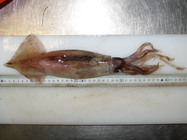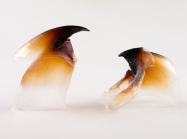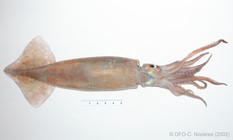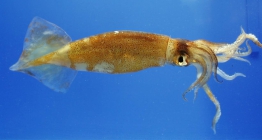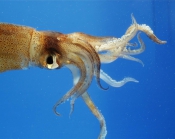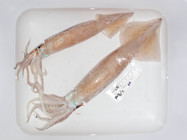
| Intro | | About | | Wiki | | Search traits | | Data explorer | | Literature | | Definitions | | Sources | | Webservices | | Statistics | | Feedback | | Editors | | Log in |
MolluscaBase taxon detailsIllex illecebrosus (Lesueur, 1821)
153087 (urn:lsid:marinespecies.org:taxname:153087)
accepted
Species
Loligo illecebrosa Lesueur, 1821 · unaccepted (original combination)
Loligo piscatorum La Pylaie, 1825 · unaccepted (synonym)
Ommastrephes illecebrosus (Lesueur, 1821) · unaccepted
marine,
(of Loligo illecebrosa Lesueur, 1821) Lesueur C.A. (1821). Descriptions of several new species of cuttlefish. <em>Journal of the Academy of Natural Sciences of Philadelphia.</em> 2: 86-101., available online at http://biodiversitylibrary.org/page/26373584
page(s): 95 [details]
Distribution western Atlantic from the Straits of Florida to Greenland and Iceland and extends eastward to the British Isles
Distribution western Atlantic from the Straits of Florida to Greenland and Iceland and extends eastward to the British Isles [details]
MolluscaBase eds. (2021). MolluscaBase. Illex illecebrosus (Lesueur, 1821). Accessed at: https://molluscabase.org/aphia.php?p=taxdetails&id=153087 on 2025-07-15
Date action by
original description
(of Loligo illecebrosa Lesueur, 1821) Lesueur C.A. (1821). Descriptions of several new species of cuttlefish. <em>Journal of the Academy of Natural Sciences of Philadelphia.</em> 2: 86-101., available online at http://biodiversitylibrary.org/page/26373584
page(s): 95 [details] context source (Deepsea) Intergovernmental Oceanographic Commission (IOC) of UNESCO. The Ocean Biogeographic Information System (OBIS), available online at http://www.iobis.org/ [details] basis of record Roper C.F.E., Lu C.C. & Vecchione M. (1998) A revision of the systematics and distribution of <i>Illex</i> species (Cephalopoda: Ommastrephidae). Pp. 405-423, in: Voss N.A., M. Vecchione, R.B. Toll & M.J. Sweeney, eds (1998) Systematics and biogeography of cephalopods. Smithsonian Contributions to Zoology 586: volume 1: 1-276; volume 2: 277-599. page(s): 408 [details] additional source Roper, C.F.E., Nigmatullin, C. & Jereb, P. (2010). Family Ommastrephidae. <i>In</i> P. Jereb & C.F.E. Roper, eds. <i>Cephalopods of the world. An annotated and illustrated catalogue of species known to date. Volume 2. Myopsid and Oegopsid Squids</i>. FAO Species Catalogue for Fishery Purposes. No. 4, Vol. 2. Rome, FAO. <em>pp. 269-347.</em> , available online at http://www.fao.org/docrep/014/i1920e/i1920e.pdf page(s): 280 [details] additional source Vechione, M., C.F.E. Roper and M.J. Sweeney. 1989. Marine flora and fauna of the eastern United States. Mollusca: Cephalopoda. NOAA Technical Report. NMFS 73. 23 p. [details]  Present Present  Inaccurate Inaccurate  Introduced: alien Introduced: alien  Containing type locality Containing type locality
Unreviewed
Diet fish, crustaceans, and smaller squid [details]Dimensions maximum size of about 350 mm ML [details] Distribution western Atlantic from the Straits of Florida to Greenland and Iceland and extends eastward to the British Isles [details] Habitat neritic to oceanic, epi- to mesopelagic [details] Habitat epipelagic [details] Importance important to commercial fisheries [details] Predators marine mammals, birds, fish [details] Reproduction sexes are separate. Fertilization is internal but eggs are laid in large communal clusters [details]
To Barcode of Life (5 barcodes)
To Biodiversity Heritage Library (74 publications) To European Nucleotide Archive, ENA (Illex illecebrosus) To FAO Species fact sheets To Global Biotic Interactions (GloBI) To IUCN Red List (Least Concern) To PESI To USNM Invertebrate Zoology Mollusca Collection To ITIS |

